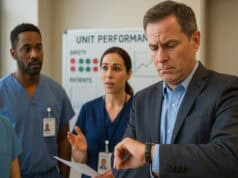I've already written one blog post about this excellent Bloomberg BusinessWeek article about the Lean transformation at GE Aerospace, a post that focused on CEO Larry Culp saying that “a problem-solving culture is far more effective operationally than a finger-pointing culture.”
AN EMPIRE DIVIDED
The inside story of how GE CEO Larry Culp dismantled a 131-year-old American giant.
In this post, I'd like to share other highlights from the article.
After an introduction that paints the scene of a Value Stream Mapping exercise, the piece shares this view of culture that I agree with:
“Culture can't be declared,” says Farah Borges, who oversees GE Aerospace's assembly, test and maintenance operations. “You have to build it.”
For example, as I would add, you can't declare a “Lean culture” or a “culture of continuous improvement.” You have to build, if not cultivate, it. You can't just declare that a “finger-pointing culture” has been replaced instantly with a “problem-solving culture” or a “culture of psychological safety.” Leaders must do the work.
The article introduces CEO Larry Culp and the concept of a “gemba walk” — even though Larry uses the also-correct spelling “genba,” as in this short, unrelated video:
Why is going to the factory floor so noteworthy? GE had gotten away from the basics of being an industrial company – but Culp has embraced the idea that they're a manufacturing company, not the vast varied conglomerate called General Electric.
“Factory floor visits aren't a radical idea for an industrial company, but GE didn't always do them this way. The company used to place more emphasis on polishing a PowerPoint presentation than on drilling into the details of manufacturing workflows, says Russell Stokes, the head of commercial jet engines and services, who's been at GE for more than 25 years.”
I don't really agree with this assessment by the article's author:
“The underlying principles of the lean manufacturing philosophy Culp preaches aren't all that different from Welch's cult of Six Sigma, another corporate dogma focused on measuring the rate of operational defects and eliminating inefficiencies.”
It's fair to say that Lean is not just a toolbox of statistical methods and improvement tools (maybe I'm selling Six Sigma short). Lean is also a management system and an operating philosophy–at Toyota, GE Aerospace, or Danaher (where Culp was previously CEO).
Here's a quote that illustrates the shift in mindset:
“Culp has been programming a new mantra into his subordinates, adapted from his time at Danaher: We're not perfect. “You'll have some home runs, but you don't need them every day,” says Jim Lico, who worked for Culp at Danaher and is now president and CEO of Fortive. “No one is perfect.” That kind of talk might've gotten a Welch-era executive fired, but it's part of Culp's belief in continuous improvement that his team routinely parrots.”
Nobody is perfect, but we're striving for perfection in a Lean culture. A Lean culture recognizes that small improvements are also great, not just the big improvements with eye-popping ROI.
The article shares examples of reducing flow time through the factory, which is going to correlate and co-exist with quality improvement when you reduce waste by improving layouts and processes. Examples included:
- Reducing cycle time from 240 minutes to just 30
- Reducing cycle time for a different part from 3 months to 3 weeks
- Reducing travel distance for a part in another factory by 3 miles (which certainly means less time)
Culp as CEO cares about such things.
“When Larry Culp shows up and wants to see how long your material's been sitting on the factory floor, that simple gesture really sets a tone.”
The article describes how Culp “loves a good kaizen [event].” How many CEOs can say that? Or would say that? The rest of the article shares a lot of details about the strategic choices that Culp has made as CEO, including the spinoffs of GE Healthcare and GE Vernova businesses.
I hope these articles inspire other CEOs and senior executives to follow this Larry Culp path and playbook.
Please scroll down (or click) to post a comment. Connect with me on LinkedIn.
Let’s work together to build a culture of continuous improvement and psychological safety. If you're a leader looking to create lasting change—not just projects—I help organizations:
- Engage people at all levels in sustainable improvement
- Shift from fear of mistakes to learning from them
- Apply Lean thinking in practical, people-centered ways
Interested in coaching or a keynote talk? Let’s start a conversation.










Dare I say it. This should be old school by now. I was in Wiremold’s first vendor kaizen in 1992. When Art Bryne walked the group through Wiremold’s empty warehouse it was eye opening. I was in Mr. Iwata’s of Shingijutsu (TBM) team doing a SMED event in the stamping press room. Yes, I heard his phase “just do it” many times that week.
Why 30 years later we still don’t understand that Lean is an holistic mindset to running an organization? The key is to engage the entire workforce including the executives to be a “little bit up every day”.
Hi Paul – Thanks for reading and for your comment.
It’s frustrating that more executives don’t understand the power of Lean as a holistic system that way.
I enjoyed reading your article and like how you emphasize the culture of continuous improvement. As you mentioned, nobody is perfect, but with the use of continuous improvement we can keep moving in the right direction and reducing waste and defects. I believe walking the gemba is important to understand the process and can highlight some challenges or opportunities that might be present. I agree that more CEOs and executives should be implementing techniques like this that will help the company improve and succeed.
Thanks for reading and commenting, Milo!